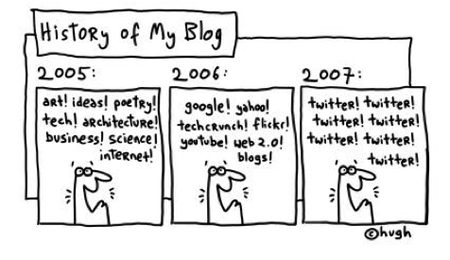Jack Dorsey is credited with the first tweet, posted on March 21, 2006. By the end of February 2007, the Twitter tweet count had reached one million. That all happened two weeks before the membership explosion triggered by the young company’s big splash at South By Southwest. Today, the most recent tweets have ID numbers 100x as large, estimating the total number of tweets at about 90 million.

source: The Gaping Void, by Hugh MacLeod (April 17, 2007)
Last week, Alex Iskold of Read/Write Web reflected on the evolution of personal publishing. He took inspiration from a claim by Twitter investor Fred Wilson that microblogging is something distinct, but grown naturally from blogging and social networking. Alex argues that sites like Twitter and Tumblr fill gaps in the space in between:
It represents a well known trend of verticalization. When new markets form they continue to be partitioned into niches. Since the gap between blogging and social networking was very wide, and the audience was quite different, microblogging emerged.
So impacting is this new channel that it has renewed the ongoing debate about the death of email. Twitter evangelists argue that email isn’t persistent, is indefensible against spam, and doesn’t work well for group interaction. Defenders of email see tweets as too short, lacking context, and potentially too low in signal-to-noise metrics. Robert Chien suggests email, while valuable, can learn a few things from Twitter, such as opening an API and adding permalinks to the mix.
Whether or not email remains the communications channel of choice, however, it is a fact that Twitter relies on email as part of its own backbone. As with most modern online communities, email is a minimal but effective means of verification that adds an important level of accountability and protection. Email exists allows Twitter to exist. It is also handy for getting around other barriers, such as the charges incurred for use of SMS with mobile phones. Email Twitter leverages email to circumvent SMS fees and service issues—a particularly timely hack given the recent problems with T-Moblie.
The interest in announcing one’s presence has given rise to other issues. Since Twitter is not the only microblogging service, message splintering is occurring as communities form around Jaiku, Pownce and others. A common solution being offered is to mass-produce messages and create redundancy in all systems. HelloTxt provides a single web form for message publishing that tries to centralize the process. It is yet to be seen if that redundancy dilutes a message or enhances it.
Some see text as too constraining. Seesmic facilitates video tweets by inviting members to not only announce what they are doing but say it in front of a camera. All of that detail, however, is not universally welcome. The United Arab Emirates banned Twitter, stating that its content is “inconsistent with the religious, cultural, political and moral values” of the nation.
Tweets are a signal that communication can occur, which is often much more important in establishing and maintaining relationships than the explicit message. Ian Curry’s description of Twitter is apt: “Like saying ‘what’s up?’ as you pass someone in the hall when you have no intention of finding out what is actually up.” A tweet is the start to a conversation, something web strategist Jeremiah Owyang calls a thread. These little interactions, regardless of form, can simply be left to dangle, or they can be lovingly crafted into a cohesive fabric. It’s a great analogy, demonstrating both scalability (connecting little actions to larger impact) and responsibility (we need to consciously cultivate and preserve the relationships we start).
By answering Twitter’s simple question, we are announcing to our corner of the world that we are ready to engage.
4 replies on “A paradigm shift towards presence”
[…] A paradigm shift towards presence Tracked by: Blog post for microblogging, about 9 hours ago […]
[…] The impact of Twitter – A paradigm shift towards presence | BlogSchmog – December 19, 2007 […]
[…] The impact of Twitter – A paradigm shift towards presence | – December 19, 2007 […]
[…] The impact of Twitter – A paradigm shift towards presence | BlogSchmog December 19, 2007Tracked on […]